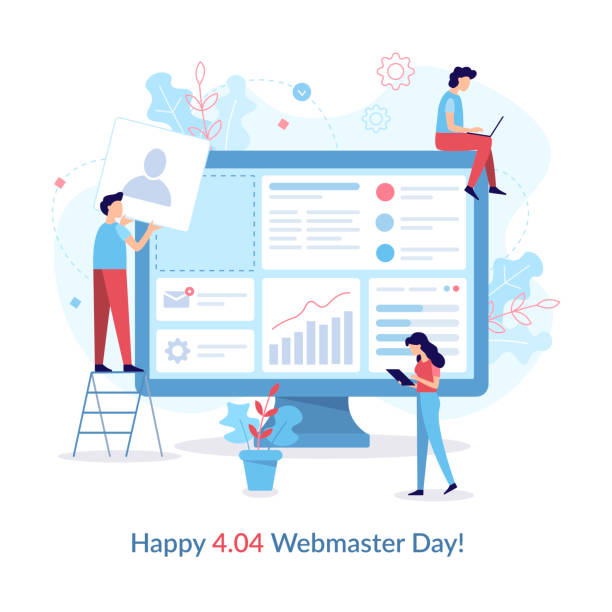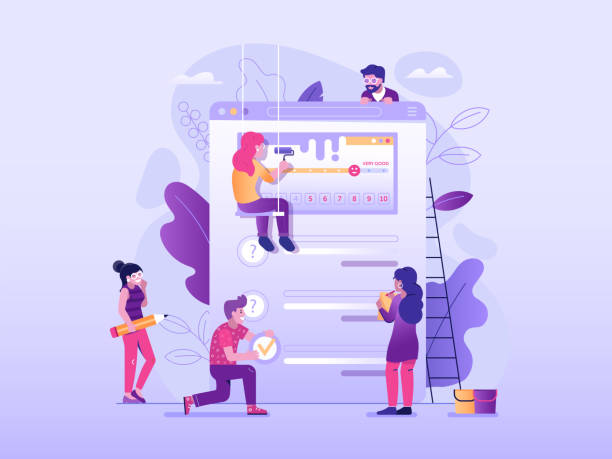Introduction to the Importance of SEO-Optimized Website Design

Today, in the digital world, simply having a #website is not enough.
To succeed online and attract your #target audience, your website must be discoverable.
This is where the concept of SEO-optimized website design becomes important.
#SEO, or Search Engine Optimization, is a set of techniques and strategies that help your website achieve higher rankings in Google and other search engine results.
This means more visits, higher credibility, and ultimately, more business opportunities.
Imagine your website offers an excellent product or service, but no one can find it; this means wasted potential.
Therefore, SEO-optimized website design is crucial from the very initial stages of building a website.
This approach not only helps increase #organic traffic but also improves user experience (UX), which is itself an important factor in Google’s ranking.
Our main goal in this educational and explanatory article is to clarify why optimization should be considered from the outset, not as an add-on after completion.
Without considering SEO principles from the beginning, you might incur additional costs and efforts for later corrections.
Website optimization has become a continuous process that requires precise #analysis and tracking.
Are you tired of your company’s website not meeting your expectations? With Rasaweb, design a professional website that truly represents your business.
✅ Increased attraction of new customers and sales leads
✅ Increased credibility and brand trust among your audience
⚡ Get a free website design consultation!
Fundamental Principles of Optimization in Web Design

To start an SEO-optimized website design project, we must be familiar with its fundamental principles.
SEO is divided into two main categories: On-Page SEO and Off-Page SEO.
On-Page SEO includes all actions you can take within your website to improve its ranking, such as keyword optimization, content quality, URL structure, title tags and meta descriptions, and page loading speed.
Optimizing content for keywords relevant to your business is of high importance. This helps search engines better understand the topic of your page.
Off-Page SEO, on the other hand, refers to activities performed outside your website to increase its authority, the most prominent of which is Link Building.
Websites that receive links from reputable and relevant sources are considered more trustworthy by search engines.
Google’s guidelines in this area are very clear and recommend focusing on providing real value to users.
A specialized approach in SEO-optimized website design involves careful planning for both aspects of SEO from the very beginning of the design process.
Ignoring any of these sections can lead to a reduction in your website’s visibility in search results.
Technical and Infrastructural Aspects in SEO-Driven Design

One of the most important aspects in SEO-optimized website design is attention to the technical and infrastructural aspects of the website.
These aspects include site loading speed, mobile-friendliness, URL structure, Robots.txt file, XML Sitemap, and the use of Structured Data.
Page loading speed is a crucial ranking factor; both users and search engines value speed. Slow websites can lead to high bounce rates and poor user experience.
Tools like Google PageSpeed Insights can help you analyze and improve site speed.
Also, given the increasing use of mobile for internet access, your website must be fully Responsive and provide an excellent user experience across all devices.
The use of an SSL certificate for website security (HTTPS) is now an essential standard and affects SEO ranking.
An explanation of best practices in this area shows that these factors are not only important for search engines but also help user trust.
In the table below, some of the most important technical factors affecting SEO and how to optimize them are listed.
This is a specialized guide for anyone looking for SEO-optimized website design from a technical perspective.
| Technical Factor | Description | Importance for SEO |
|---|---|---|
| Site Loading Speed | Time required for the full content of the page to display | Very High (Direct Ranking Factor) |
| Responsiveness (Mobile-Friendly) | Site compatibility with various devices and screen sizes | Very High (Mobile-first Indexing) |
| Use of HTTPS | Encryption of communication between user and website | High (Ranking Factor) |
| Optimized URL Structure | Short, meaningful, and containing keywords | Medium to High (Readability and Search Engine Comprehension) |
Content Strategy and its Role in SEO-Optimized Design

Content is king; this statement holds true more than ever in the world of SEO.
An SEO-optimized website design would be meaningless without high-quality and relevant content.
A content strategy for SEO includes identifying appropriate keywords, producing valuable and unique content, and optimizing it for search engines.
Keyword research is the first and crucial step. You need to know what your users are looking for and what phrases they use to search.
Then, create your content around these main and secondary keywords.
Your content must be comprehensive, accurate, and responsive to user needs.
Instead of solely focusing on keywords, the goal should be to provide real value that attracts and retains the audience.
Google rewards long-form and in-depth content that fully covers a topic.
Using relevant images and videos can also help make content more appealing and reduce bounce rate.
There are many educational articles in this area that you can use.
Producing thought-provoking content that prompts users to interact and encourages sharing is a smart strategy.
Regular content updates also signal to search engines that your website is active and relevant.
Are you dissatisfied with the low conversion rate of visitors to customers on your e-commerce site?
Solve this problem forever with professional e-commerce website design by Rasaweb!
✅ Increase visitor-to-customer conversion rate
✅ Create an excellent user experience and build customer trust
⚡ Get a free consultation
User Experience (UX) and its Connection to SEO-Optimized Design

Did you know that User Experience (UX) directly impacts SEO? Yes, Google ranks websites that offer a positive user experience higher.
SEO-optimized website design does not only mean optimizing for search engine robots, but also optimizing for humans.
A website that is difficult to navigate, where information is hard to find, or that does not display correctly on mobile, will not rank well, even if it is technically excellent.
Factors such as page loading speed, ease of use (usability), attractive visual design, and logical navigation structure all contribute to an excellent user experience. Search engines can estimate the quality of user experience through metrics such as Bounce Rate, Dwell Time, and Click-Through Rate (CTR).
A website that users quickly leave or spend little time on sends a negative signal to Google.
A website with SEO-optimized design and strong UX encourages users to stay longer, visit more pages, and interact more.
This approach means a detailed analysis of user behavior and implementing necessary changes for continuous improvement.
Ultimately, a site that satisfies users not only gets a better ranking but also helps you achieve your business goals.
Link Building and Authority Enhancement in SEO-Driven Design

Link Building is one of the pillars of Off-Page SEO and plays a vital role in SEO-optimized website design.
Links act like votes of confidence from other websites.
The more quality and relevant links your website receives from reputable sites, the more your Domain Authority and Page Authority will increase, consequently improving your ranking in search engines.
This process should be done naturally and organically, as spam or purchased links can cause serious damage to your website.
Producing very high-quality content that is naturally shared by others is the best way to attract links. Participating in online communities, guest posting on relevant blogs, and building relationships with influencers and publishers can also help you with link building.
This is a specialized and time-consuming process that requires strategy and follow-up.
Google strongly emphasizes the quality and relevance of links, not their quantity.
Remember that a link from an irrelevant or low-authority website can have a negative effect.
This section of SEO guidance and strategies is often recognized as one of the most challenging parts, but its reward for a search engine-optimized website is immense.
Monitoring and Data Analysis for Continuous Optimization

An SEO-optimized website design is only the starting point.
To ensure continuous effectiveness and ongoing improvement, monitoring and data analysis are essential.
Tools like Google Analytics and Google Search Console provide vital information about your website’s performance in search engines.
Google Analytics allows you to track website traffic, user behavior, traffic sources, and conversion rates. This data shows you which pages are more popular, how users navigate your site, and what obstacles exist on their path to becoming customers.
Google Search Console also provides valuable information about how your site appears in search results, the keywords users use to find you, technical issues, and incoming links.
By analyzing this data, you can identify your website’s strengths and weaknesses and optimize your SEO strategy.
Numerous tutorials are available for using these tools.
This continuous analytical process enables you to respond to changes in Google’s algorithms and user needs, keeping your website always optimized.
The table below presents the most important SEO analysis tools and their effectiveness for monitoring the performance of an SEO-optimized website design:
| Row | Tool Name | Main Functionality | Why is it important? |
|---|---|---|---|
| 1 | Google Analytics | Traffic analysis, user behavior, conversion rate | Full understanding of user performance on the site |
| 2 | Google Search Console | Monitoring search performance, indexing issues, keywords | Direct insight into Google’s view of your site |
| 3 | Ahrefs/Semrush | Backlink analysis, keyword research, competitor analysis | Comprehensive tools for advanced SEO and competitive analysis |
Common Mistakes in Web Design and Optimization

On the path to SEO-optimized website design, avoiding common mistakes is very important.
One of the biggest mistakes is ignoring keyword research or misusing them. Excessively stuffing content with keywords (Keyword Stuffing) not only does not help your SEO but can also lead to Google penalties.
Another mistake is neglecting user experience.
A beautiful website with difficult navigation or slow speed will ultimately lose users and, consequently, SEO rankings.
Furthermore, failing to optimize for mobile is a major error in today’s world.
News and reports indicate that Google undervalues websites not optimized for mobile.
Not using alt tags for images, lacking meta descriptions, and inappropriate URL structure are also common mistakes.
Some websites use Black Hat SEO techniques, which might yield good results in the short term, but are eventually identified by Google and lead to the complete removal of the website from search results.
For a sustainable SEO-optimized website design, always follow White Hat SEO techniques and seek long-term solutions.
Does your current website build the trust that potential customers should have in your business? If the answer is no, it’s time to have your professional and impactful corporate website with Rasaweb.
✅ Fully customized design tailored to your brand identity
✅ Increased lead generation and business credibility in the eyes of customers⚡ Contact us for a free consultation!
The Future of SEO and the Role of Artificial Intelligence in Web Optimization

As technology advances, so does SEO.
The future of SEO-optimized website design is heavily intertwined with Artificial Intelligence (AI) and Machine Learning.
Google is increasingly using AI to better understand user search intent and evaluate content quality.
Algorithms like RankBrain, BERT, and MUM indicate that Google is moving towards a deeper semantic understanding of content and natural language. This means that the focus is no longer solely on specific keywords, but rather on understanding topics, connections between concepts, and providing comprehensive and complete answers to complex user queries.
Websites should focus on producing comprehensive and topic-centric content that fully addresses user needs, rather than concentrating on specific keywords.
Voice Search SEO is also growing due to the increased use of voice assistants like Siri and Google Assistant.
This is a thought-provoking discussion on how SEO strategies should adapt to these significant changes.
Continuous news and analyses in this field are essential for maintaining the position of an SEO-optimized website design.
The future of SEO is moving towards user experience and semantic relevance becoming more important than ever.
Conclusion and Step-by-Step Guide to Success

In conclusion, SEO-optimized website design is a complex and multifaceted process that requires meticulous planning, correct execution, and continuous monitoring.
From technical and infrastructural optimization to producing quality content and link building, each part plays an important role in your website’s visibility in search engines.
Remember that SEO is not a sprint, but a marathon.
SEO results may not appear immediately, but with continuous tracking and adherence to correct principles, you will certainly see its fruits.
Always focus on providing real value to users, as Google increasingly values the quality of user experience. By staying up-to-date with the latest algorithms and SEO trends, and using analysis tools, you can keep your website at its peak.
This is a comprehensive guide for anyone looking to succeed in the online space through SEO-optimized website design.
By implementing these strategies, you will not only increase your website traffic but also strengthen your brand credibility and get closer to your business goals.
Frequently Asked Questions
| Row | Question | Answer |
|---|---|---|
| 1 | What is an SEO-optimized website? | It is a website designed and developed according to Search Engine Optimization (SEO) principles to achieve higher rankings in search results. |
| 2 | Why is having an SEO-optimized website important? | It increases visibility, attracts organic traffic, boosts conversions, and builds brand credibility, all of which contribute to business growth. |
| 3 | What are the key elements of SEO-optimized website design? | Technical SEO (speed, mobile compatibility), On-Page SEO (keywords, content), User Experience (UX), and website security (HTTPS). |
| 4 | How does website speed affect SEO? | Faster sites improve user experience, reduce bounce rates, and are favored by search engines, leading to better rankings. |
| 5 | Is mobile compatibility important for SEO? | Absolutely. Google uses mobile-first indexing, so responsive design for mobile is crucial for ranking. |
| 6 | What role does content play in SEO-optimized website design? | High-quality, relevant, and keyword-optimized content is fundamental for attracting users and signaling relevance to search engines. |
| 7 | What is keyword research and why is it important? | Finding popular search phrases that people use. This process helps align content with user intent and attracts relevant traffic. |
| 8 | How is User Experience (UX) related to SEO? | Good UX (easy navigation, readability) keeps users on the site longer, reduces bounce rate, and sends positive signals to search engines. |
| 9 | What is a Sitemap and how does it help SEO? | It is a file that lists all pages of a site. It helps search engines crawl and index your site more effectively. |
| 10 | Should I use HTTPS for my website? | Yes, HTTPS provides security and is considered a minor ranking factor. It also increases user trust. |
And other services of Rasaweb Advertising Agency in the field of advertising
Smart Direct Marketing: An innovative platform for improving SEO ranking with marketing automation.
Smart Digital Branding: A combination of creativity and technology to increase website visits through the use of real data.
Smart Customer Journey Map: An innovative platform for improving customer behavior analysis with SEO-driven content strategy.
Smart UI/UX: Professional optimization for customer acquisition using user experience customization.
Smart Custom Software: A combination of creativity and technology to increase sales through intelligent data analysis.
And over a hundred other services in the field of internet advertising, advertising consultation, and organizational solutions
Internet Advertising | Advertising Strategy | Advertorial
Sources
SEO-Optimized Website Design: Step-by-Step to Top Ranking
Comprehensive Guide to SEO and Website Optimization
Increasing Online Visibility with Powerful SEO
On-Page SEO Checklist for Website Design
? For visibility and leadership in the digital world, Rasaweb Afarin Digital Marketing Agency is with you. By offering comprehensive services including personal website design, SEO, and social media management, we will elevate your business to its peak.
📍 Tehran, Mirdamad Street, next to Central Bank, Southern Kazeroun Alley, Ramin Alley, No. 6
